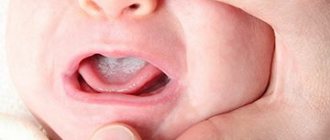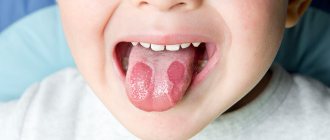What are mouth ulcers in children?
The mucous membranes of the oral cavity are very sensitive and even minor damage causes peeling of the upper epithelial layers with the formation of ulcers. Such formations can be single or multiple, small and large. One pathology is characterized by the appearance of red ulcers, the other - white ulcers. They can be either clean or purulent. Their localization can also be very diverse: ulcers on the tongue, under the tongue, on the surface of the gums, cheeks, palate or lips.
Mouth ulcer in a 5 year old child
There are no age restrictions on the occurrence of such a problem. Mouth ulcers can occur in a newborn, a one-year-old child, or a child 5 years of age or older.
What do the wounds that appear in the child’s mouth indicate?
Having noticed a bright red or white wound in a child’s mouth, experienced parents will immediately suspect stomatitis: the widespread prevalence of this disease among preschool children is explained by at least two factors - an underdeveloped immune system, which is not yet capable of providing full protection against infections, and habit in a rush children's curiosity to put toys, small objects and even their own fingers into their mouths.
Often the disease develops as a result of injury to the mucous membrane:
- sharp edges of teeth;
- hot, spicy, cold or hard foods;
- due to malocclusion;
- aggressive chemicals.
Depending on the nature of the disease, it can have an acute or chronic form. Acute stomatitis develops within a few days after the lesion:
- herpes virus;
- enterovirus;
- fungus;
- streptococci or staphylococci and other infections.
Many pathogens belong to opportunistic microflora, which constantly lives in the oral cavity, but only under certain circumstances provokes the development of symptoms of the disease.
As a rule, an acute outbreak passes quickly (sometimes even on its own, without treatment), but a high predisposition to relapses persists for a long time.
Chronic stomatitis is difficult to treat: as soon as the mucous membrane in the primary lesion is restored, a new wound appears elsewhere, and this process can proceed in waves for weeks and months. If left untreated, degeneration of the mucous membrane may develop, and subsequently leukoplakia (keratinization of individual areas).
Stomatitis happens:
- catarrhal;
- aphthous;
- ulcerative-gangrenous.
The catarrhal form of the disease is considered the simplest, although it may be accompanied by:
- increase in body temperature to subfebrile levels;
- the appearance of bad breath;
- increased salivation;
- soreness of the mucous membrane (especially during eating or talking).
Aphthous stomatitis is so named because of the appearance of round or oval ulcers in the mouth - aft (the top of such a wound is usually covered with a white or gray coating).
Aphthae take a long time to heal, up to several weeks; as the disease progresses, relapses occur more often.
If stomatitis becomes necrotic or scarring, the healing period may increase to several months.
The ulcerative gangrenous form is the most severe, it is accompanied by deep damage to the mucous membrane and a pronounced disturbance in general health, which requires immediate medical intervention.
Causes
The appearance of ulcerations on the mucous membranes in the oral cavity can be a signal of both local pathology and a general disease.
- Stomatitis is one of the most common diseases in pediatric dentistry. It can be viral or infectious in nature, or be the result of injury or immunological disorders. With this pathology, ulcers form against the background of severe inflammation and appear as multiple white formations on a bright red background. They can be located anywhere in the oral cavity or in the corners of the mouth. With stomatitis, the child complains of severe pain in the mouth, the general condition is often disturbed, and the body temperature rises.
- Herpes infection - caused by the herpes simplex virus. With it, multiple small blisters form in the mouth, which very quickly open and form shallow, but very painful red ulcers. At the same time, herpetic rashes can also be found on the skin around the mouth. Similar blisters and ulcers form in the mouth of a child and with chickenpox (the virus that causes this disease belongs to the Herpes genus). Their distinctive feature is that they are rarely located in groups and are more often single, and bubbles typical of chickenpox can also be seen around the mouth.
- Oral candidiasis is a common pathology that occurs in children under one year of age. The baby's immunity is not fully formed, and breast milk is an excellent environment for the development of candida fungi. With this disease, an abundant white cheesy coating forms on the mucous membranes of the mouth, after removal of which small ulcers are exposed. Although the disease is not severe, such white plaque and sores cause discomfort and pain to the baby, which can cause him to become restless and refuse to eat.
- Allergic reactions in children are not uncommon. In most cases, they manifest themselves as rashes on the skin, but sometimes allergies affect the oral mucosa. In this case, against the background of itching and redness, ulcers of various sizes and locations are formed, which are very itchy and cause anxiety in the child.
- Traumatic ulcers in the oral cavity are also quite common in childhood. They arise due to poor hygiene and too rough manipulation with a toothbrush, in case of damage to the mucous membranes with sharp objects or when accidentally biting soft tissues. This pathology is most often characterized by the presence of one ulcer of various sizes, around which there may be inflammatory changes and redness of the mucous membrane.
- Thermal or chemical burns . Children under 5 years old often try to taste unfamiliar liquids. As a result, burns of the mucous membranes are common. In this case, ulcers of various sizes and depths are formed, which can be covered with both purulent plaque and necrotic epithelium. In the diagnosis of such a pathology, an important role is played by collecting anamnesis and finding out which aggressive factor caused its development.
Causes of sores in a child’s mouth
- Candidiasis (thrush) is an inflammation of the oral mucosa under the influence of yeast-like fungi such as Candida. It manifests itself as itching, burning, white coating on the tongue, the inside of the cheeks, gums, and palate. Under the plaque lies swollen, inflamed tissue. If the form is mild, it can be removed with a spatula. With severe candidiasis, the plaque acquires a yellow tint, becomes dense, often extends to the inside of the lips and corners of the mouth, and the area underneath becomes loose and may bleed. The child's general condition worsens, characterized by lethargy, fever, and refusal to eat.
- Herpes is a lesion of the oral mucosa caused by the herpes virus. The disease begins with redness and swelling of the oral cavity, then rashes appear in the form of blisters with clear or cloudy liquid inside. Next, the blisters open and in their place ulcers with yellow crusts form. Herpetic stomatitis is characterized by itching, pain (especially when eating), high fever and headaches.
- Catarrhal stomatitis is a lesion of the oral mucosa, usually caused by poor hygiene, caries, and changes in hormonal levels. It manifests itself as swelling, a grayish coating, white, yellow or red erosions and ulcers.
- Injuries - damage to the oral cavity from rough or hot food, sharp edges or chipped teeth, toys and other objects that a child can drag into the mouth. The use of concentrated chemical solutions and liquids also causes erosion in the oral cavity. The wounds are localized on the inside of the lips, cheeks, palate, tongue, throat, and have a white, grayish, yellow or red tint. Ulcers cause pain and discomfort while eating.
- Allergy – contact with an allergen (medicine, oral care product, new food product, animals, insect bites, etc.) can lead to allergic reactions in the form of a rash of blisters on the mucous membrane of the mouth and throat. In their place, after opening, erosions with white or yellow crusts form.
It is necessary to detect the allergen as soon as possible and exclude the child from contact with it. Otherwise, allergic reactions may worsen.
In addition to the above reasons, sores in the mouth may indicate any serious illness: tuberculosis, pneumonia, HIV, cancer, diabetes, ARVI. In addition, ulcers in the baby’s mouth are primarily a signal of weakened immunity and vitamin deficiency.
If erosions or plaque appear in the oral cavity, it is necessary to show the child to a pediatrician or dentist.
Treatment
A dentist treats mouth ulcers. It is he who prescribes therapeutic measures that must be carried out at home until all defects in the oral cavity heal.
Despite the fact that the causes of mouth ulcers can be very diverse, there are some common points in their treatment:
- If ulcers cause severe discomfort and pain, then NSAIDs (paracetamol or ibuprofen) can be used to relieve pain and relieve inflammation. The same drugs are also indicated in the presence of high fever.
- After eating and before going to bed, it is necessary to treat the oral cavity with an antiseptic solution. For such purposes, you can use an aqueous solution of chlorhexidine, furatsilin, miramistin.
- For older children, local preparations with analgesic and wound-healing effects (metrogil dental, solcoseryl paste) can be used. Any of the drugs is applied to the affected area using a sterile cotton swab 3-4 times a day.
- A mandatory point is to follow a gentle diet with the exception of irritating foods: salty, spicy, sour, too hot. It is advisable that all food be warm and soft. In especially severe cases, with severe pain, you can offer the child to feed ground liquid food through a tube.
- You should not try to treat ulcers with solutions of brilliant green or blue, as this can cause additional irritation of the mucous membranes and increased pain.
In addition to general points, it is necessary to carry out therapeutic measures aimed at eliminating the cause of the disease or the appearance of ulcers in the mouth. Only the dentist decides how to treat them.
In case of herpes infection, antiviral drugs and immunostimulants are indicated. For candidiasis, antifungal agents are prescribed. If the cause of oral ulcers is an allergy, then the use of antihistamines is necessary.
If the ulcers are of a primary bacterial nature or have a secondary infection, in some cases it is advisable to prescribe antibiotics with a broad spectrum of action.
Traditional methods of treatment
Sometimes, in addition to the main course of therapy, the dentist may recommend traditional medicine.
- Herbal decoctions (chamomile, calendula, string, oak bark) have a pronounced anti-inflammatory effect, are excellent natural antiseptics and accelerate tissue healing processes. For children, it is recommended to prepare decoctions daily and rinse the mouth up to five times a day. Such treatment is permissible only after two years of age.
- Sea buckthorn oil perfectly stimulates tissue regeneration. For treatment, it is necessary to apply a thin layer of sterile natural oil to the area of the ulcers twice a day.
- Natural honey is rich in vitamins and minerals, therefore it helps improve blood circulation in tissues, reduce inflammation and stimulate regeneration. Apply fresh natural honey to the ulcer using a sterile swab 2 times a day.
Prevention
Preventing mouth ulcers in a child is not particularly difficult:
- Parental quality control of personal oral hygiene.
- Carrying out activities to strengthen the natural immunity of the child’s body.
- Monitoring that the child does not put sharp objects into his mouth or try to drink an unfamiliar liquid.
- Timely treatment of allergies and prevention of their recurrence.
If a baby or older child develops mouth ulcers, this is a reason to see a doctor as soon as possible. Even if they do not cause any negative reactions in the baby, they can still be a marker of a serious pathology, which without treatment will negatively affect health in the future.
Causes
Oral diseases
- Aphthous stomatitis . The development of such a disease can be triggered by several factors. These include weakened immunity, disruption of the endocrine system, and viral infections. Ulcers caused by aphthous stomatitis are observed on the gums, palate and cheeks. These are white or white-yellow sores that cause discomfort when touched. In this case, rinsing the mouth with a decoction of calendula is indicated.
- Viral stomatitis . With this disease, there are many small white sores in the mouth. They are located on the back of the cheeks and pharynx, as well as on the gums. To treat sores, a light pink solution of potassium permanganate is used. It is necessary to understand that viral stomatitis is a contagious disease, so it is necessary to adhere to safety measures. So, the dishes of a sick child should be stored separately. It should be thoroughly washed and scalded with boiling water each time. Food should be unsalted and non-spicy. You need to feed your baby in small portions, because severe pain occurs when eating food.
- Herpes . With this disease, many ulcers form in the child’s mouth. Herpes does not always appear. This requires favorable conditions such as weakened immunity or cold weather. First, several bubbles form on the mucous membrane. Over time, they burst, leaving behind small ulcers with a grayish film. In this case, severe pain, fever, increased salivation and an unpleasant odor are observed. Special ointments and rinses are used for treatment.
Vitamin deficiency
The formation of ulcers in children often occurs due to a lack of various vitamins.
- Vitamin B2 . A deficiency of this vitamin causes cracks in the corners of the lips and white sores in the mouth. Other symptoms include conjunctivitis, insomnia, watery eyes, and even vomiting. Eating dairy products, liver and kidneys, buckwheat, green peas and spinach will help fill the deficit.
- Vitamin B 6 . In this case, cracks are noticeable on the lips, and multiple ulcers are visible on the mucous membrane. To improve the child’s condition, it is worth introducing rice bran, legumes, peanuts and liver into the diet.
- Vitamin P The main symptoms of its deficiency include the formation of ulcers on the tongue, gums and severe inflammation of the mucous membrane. The vitamin is found in a variety of foods, including poultry, fish and liver.
- Vitamin C. Due to a lack of this vitamin, the gums become blue. They become swollen and often bleed. Upon careful examination, you may notice ulcers in the mouth. To normalize the condition, it is necessary to compensate for the lack of vitamin contained in citrus fruits, currants, rose hips, and raspberries. You can also give your child additional ascorbic acid.
Other reasons
- Frequent consumption of sweets.
- The predominance of acidic foods in the diet.
- Constant biting of the cheeks, which leads to injury to the mucous membrane and subsequent formation of ulcers.
- Illiterate use of an electric brush.
- Injury to the oral mucosa by the sharp edges of a filling or denture.








